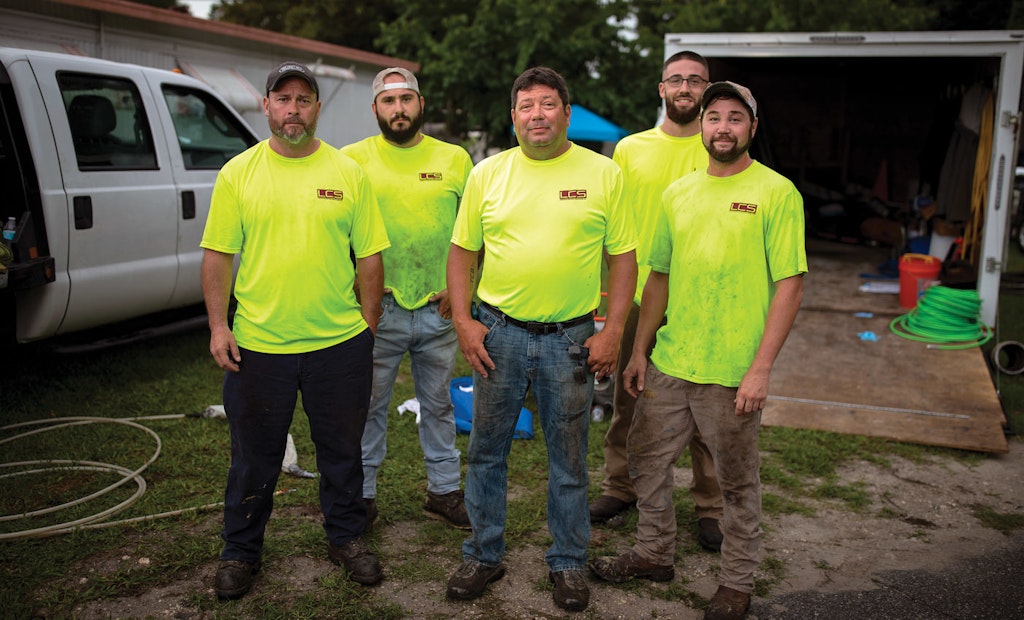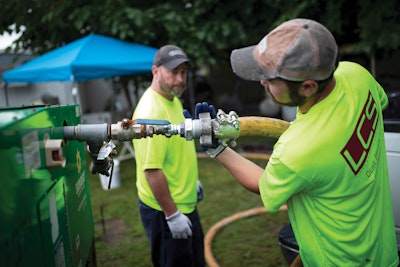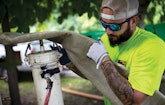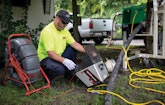
The Lining & Coating Solutions crew includes (from left) Chris Vajcovec, Anthony Confalone, owner Steve Palmer, Austin Larsen and Austin Palmer.
Interested in Relining/Rehab?
Get Relining/Rehab articles, news and videos right in your inbox! Sign up now.
Relining/Rehab + Get AlertsWhen Steve Palmer saw the trenchless relining trend developing, he saw opportunity.
An industry veteran and master plumber, Palmer made a career out of starting and developing plumbing companies for others. While managing a plumbing department for a large company, he decided to add lining and coating services, and in just a few years, that work was surpassing the plumbing side. When the owners were ready to take full management, Palmer decided to embrace this specialty niche, this time for himself.
He approached a larger firm, Upchurch Cos., with his idea, and they backed his venture. Palmer is now general manager of Lining & Coating Solutions, which has quickly gained a reputation for quality workmanship and a willingness to take on rehabilitation jobs that other contractors shy away from.
Setting the stage
Headquartered just outside Memphis, Tennessee, in Olive Branch, Mississippi, with a branch in Tampa, Florida, LCS has a crew of 10 that deploys from both locations as client projects demand. Palmer knew that lining and coating services could be lucrative and had seen firsthand how a focused effort to gain the trust of industrial and commercial clients — including manufacturing facilities, power plants, chemical plants, hospitals, schools and apartment complexes — can pay off.
“In the industrial market, managers prefer a sole source — one guy with all the different tools to serve all their varying needs like tanks, water pipe, pressure pipe, sewer, storm drains and manholes,” Palmer explains. “We had long-standing relationships with the industrial plants to handle their plumbing needs, so it was a natural progression to be able to offer them lining services. It was an easy sell to get rehabilitation projects.”
Knowing that marketing and networking would be key to building a large client base, Palmer began reaching out to other plumbing contractors who were also doing industrial work but didn’t offer rehabilitation services. By doing this, he was able to acquire lining projects through these firms, giving those companies an opportunity to become a sole source repair, maintenance and rehabilitation vendor to their own customers.
Although LCS doesn’t actively seek larger municipal lining projects, they do solicit for small, specialty projects that larger sewer service contractors can’t perform profitably — such as a small municipality that needs 1,000 feet of mainline relined and five manholes rehabilitated. Those projects became a specialty niche for LCS and keep them very busy. Conversely, they also fill a void for smaller plumbing contractors and lining companies that have leads for projects that are beyond their staff or equipment capabilities. “We get a lot of business from the internet. Our website generates lots of interest, and almost 40% of our work comes from these other plumbing companies and smaller pipeline rehabilitation firms,” Palmer says.
For mainline projects, LCS uses products from Masterliner Inc. The company also keeps bulk resin and transitional liners from HammerHead Trenchless on hand, and uses a Picote Solutions epoxy pump, resins from Schwalm USA, and flex liners and scrim liners from Perma-Liner Industries. “No one company is a one-stop shop, so you have to have relationships with everyone to make a job with multiple size pipes and installation requirements work.”
Conservation creates opportunity
Recent water conservation methods and devices have created an unexpected business opportunity for LCS and other lining firms. Facilities choosing to upgrade their plumbing with water-saving devices such as low-flow commodes and faucets save energy and resources; but those updates in buildings with older pipes, cast iron in particular, lower the flow and create backup issues.
Case in point was a large high school in Indiana that had recently performed such an upgrade and didn’t anticipate the ensuing flow issues and backups. The project was challenging due to a very tight time frame for completion. LCS crews were given from when school closed for summer in June until just after Labor Day. The project involved descaling, flushing and lining 8,000 feet of cast iron pipe that encompasses the mainlines outside the perimeter of the school building and all interior building drains. The drains spanned from 2 to 8 inches in diameter, and while most could be accessed through fixtures, vent stacks or clean-outs, many involved floor drains with a 2-inch P-trap.
The lining was performed using traditional drum-inversion CIPP with steam or hot-water cure. The crews would line several mainlines each day, cap them and leave them to cure overnight, returning the second day to perform robotic cutting to reinstate. The team of 10 worked six days a week on 12-hour shifts. Some weeks they took no days off in order to meet the deadline and handle other project commitments.
The tougher the better
“I like it when somebody says they have a project that everyone else says can’t be done. I like trying to figure out a way to do it and make it a long-term solution,” Palmer says. “We have a sweet spot: specialty equipment and small crews. We let others do the heavy lifting, and then we can come in and handle the delicate or more unusual lining processes and fix the problem.”
Such was the scenario at a nuclear power facility. An unusual increase to 20,000 gallons of water coming into the system revealed an obvious inflow-and-infiltration issue somewhere in the facility. The source of the infiltration was discovered to be a nearby river from which water was drawn to cool the facility reactors that ran under a thick concrete slab.
Several contractors were called in to assess the situation, but no one could determine how to reline or rehabilitate the pipe due to the location and the small, 4-inch access holes to the 8- and 10-inch-diameter pipes. There were four different runs, each with four to six 90-degree bends each. After searching for a solution for over a year, Palmer was called in by the plant and developed a way to handle the job. Crews were required to go through extensive training before the project could commence, and the entire process took approximately 2 1/2 months to complete, with a total of 1,000 feet of pipe being rehabilitated successfully. The job was completed without interruption to the plant.
Unexpected help
Palmer has come to value networking and cooperation, even with the competition. “There’s enough work to go around for everyone, and you never know when another contractor can be your best ally,” he says.
During another challenging project at a hospital that was experiencing similar issues as the school due to plumbing fixture upgrades and long-term buildup and tuberculation on older lines, the demands on Palmer’s cutting and mechanical cleaning equipment took their toll. The LCS crews had to be very aggressive with the cleaning, lining and quick reinstatement in order to not interfere with the hospital’s operation. In the four wings of the building, cleaning was performed during the day and installation of the liners during the evening, when flows were at their lowest point. The lines had numerous laterals coming in so getting the lines back in service quickly was paramount.
For this project, Palmer had brought three cutters: two robotic and one manual. By the end of one week and 56 reinstatements, all three units were down. “Robotics in sewers don’t work well in projects like these, as nine out of 10 lines will have been used during the lining cure process and as the laterals get reinstated. All that backed-up water gets dumped on the equipment, and they can only take so much before they need to be maintained and serviced,” he explains.
Palmer called upon a good friend who builds equipment and repairs cutters. A few weeks prior, this vendor had another client with a similar issue of cutters going down, and Palmer offered to send one of his team and his equipment to help them finish their project. As a result, in Palmer’s own hour of need, the vendor was able to find someone to return the favor; and within a very short window of time, help was on site to help Palmer and his crews finish the final three reinstatements. “It’s good to be friendly and network. When someone needs help and you can, help them. You never know when you’ll need the favor returned,” Palmer shares.
Look before you leap
Before adding to his lineup, Palmer asks vendors for contacts of their clients and personally visits them to see the product or process working in a real-world environment. His philosophy is that because they are also contractors, living with the equipment and looking to be profitable from its use, they will offer honest feedback on their experience. He also speaks to contractors who were interested in the same product but chose to go a different route. All of these interactions create a bigger network of contacts and resources for know-how and sources of new work.
LCS is always open to new opportunities or things that add value to its niche specialty, but Palmer takes a cautious approach to beginning new ventures. “I don’t jump into anything unless I’ve already got enough projects lined up to get me into it,” he says. “Don’t be afraid to ask the tough questions and share information when you’re considering something new.”
DIY technology expands the toolkit
Preferring spincasting application to blow-in epoxy for smaller-diameter pipes for certain applications, Steve Palmer, general manager of Lining & Coating Solutions decided he wanted the benefits of being able to offer this rehabilitation method but needed to bring it on board at a nominal cost.
The answer: Build your own spinner. After looking at some high-priced rigs that offered built-in computers, timers, automated winches and pulleys with thickness analysis readouts, Palmer asked his clients if all of these features were really necessary or that important to them. The consensus was that as long as Palmer and his crew could perform the process as required using their existing field-proven methods, a simple spincaster with a camera for monitoring application would suffice. In the rare instance where, after an application, an area needs an additional pass of coating to increase thickness, it can be readily accomplished.
With this positive response, Palmer moved forward with creating his own spinner and uses Warren Environmental, Picote Solutions, Behr and Sherwin-Williams epoxy products for his projects. With the DIY spinner, LCS is able to complete projects successfully without all the “bells and whistles” and to pass on the overhead savings to its customers and gain a better profit margin on spincasting projects.











